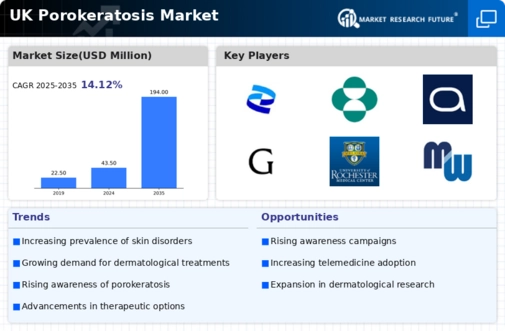Increasing Incidence of Porokeratosis
The rising incidence of porokeratosis in the UK is a crucial driver for the porokeratosis market. Recent studies indicate that the prevalence of this skin condition is on the rise, particularly among older adults. This increase is likely attributed to factors such as prolonged sun exposure and genetic predisposition. As more individuals are diagnosed, the demand for effective treatment options and management strategies intensifies. The UK healthcare system is responding to this trend by allocating more resources towards dermatological research and treatment facilities. Consequently, this growing patient population is expected to propel the porokeratosis market, as pharmaceutical companies and healthcare providers seek to develop innovative therapies and improve patient outcomes.
Increased Focus on Patient-Centric Care
An increased focus on patient-centric care is shaping the porokeratosis market in the UK. Healthcare providers are increasingly prioritising the needs and preferences of patients in their treatment approaches. This shift is likely to lead to the development of tailored treatment plans that consider individual patient characteristics and lifestyle factors. Moreover, the integration of patient feedback into treatment protocols is expected to enhance patient satisfaction and adherence to therapies. As healthcare systems evolve to embrace this patient-centric model, the porokeratosis market is anticipated to benefit from improved treatment outcomes and a more engaged patient population. This trend may ultimately drive market growth as patients seek effective and personalised solutions for their condition.
Growing Demand for Dermatological Services
The growing demand for dermatological services in the UK is a significant driver for the porokeratosis market. As awareness of skin health increases, more individuals are seeking consultations with dermatologists for skin-related issues, including porokeratosis. This trend is reflected in the rising number of dermatology clinics and specialists across the country. According to recent statistics, the dermatology sector has experienced a growth rate of approximately 5% annually. This surge in demand is likely to lead to an increase in diagnostic procedures and treatment options available for patients. Consequently, healthcare providers are expected to expand their offerings, thereby positively impacting the porokeratosis market.
Regulatory Support for Innovative Treatments
Regulatory support for innovative treatments is emerging as a key driver in the porokeratosis market. The UK regulatory bodies are increasingly facilitating the approval process for new dermatological therapies, which encourages pharmaceutical companies to invest in the development of novel treatments. This supportive environment is likely to expedite the availability of effective therapies for porokeratosis, addressing the unmet needs of patients. Additionally, initiatives aimed at streamlining clinical trial processes are expected to enhance the speed at which new treatments reach the market. As a result, the porokeratosis market is poised for growth, driven by the introduction of advanced therapeutic options that improve patient care.
Enhanced Research and Development Initiatives
The porokeratosis market is significantly influenced by enhanced research and development initiatives within the UK. Government and private sector investments in dermatological research are increasing, leading to a better understanding of porokeratosis and its underlying mechanisms. This focus on R&D is likely to yield new treatment modalities, including topical therapies and systemic medications. Furthermore, collaborations between academic institutions and pharmaceutical companies are fostering innovation in drug development. As a result, the market is expected to witness a surge in novel therapeutic options, which could improve patient adherence and satisfaction. The commitment to advancing research in this area is anticipated to drive growth in the porokeratosis market over the coming years.
























Leave a Comment